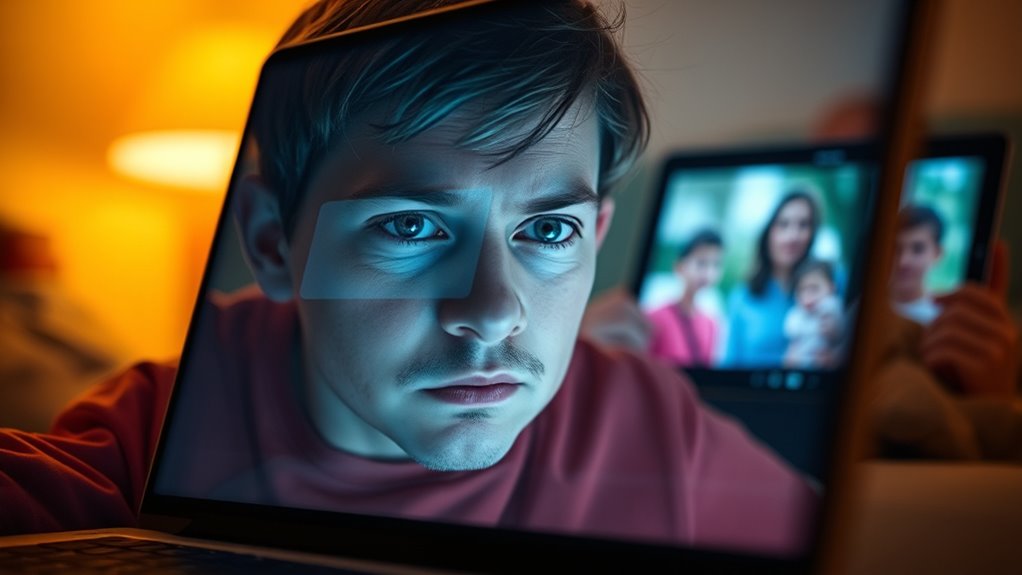To spot deepfakes before your kids share videos, look for signs like unnatural blinking, odd facial movements, or inconsistent lighting. Use trusted detection tools that analyze videos for these subtle clues without compromising privacy; prefer those that work locally on devices. Educate your children about the risks of fake videos and encourage them to verify content before sharing. Staying informed and applying these methods can help safeguard your family from digital deception—find out more to stay ahead.
Key Takeaways
- Use deepfake detection tools that analyze videos for irregular blinking, unnatural movements, and lighting inconsistencies before sharing.
- Prioritize privacy by choosing tools that process videos locally, avoiding uploading personal content to external servers.
- Educate children about deepfakes, encouraging critical thinking and verification before sharing videos online.
- Stay updated on new detection methods and common signs of manipulated videos to better identify fakes.
- Combine technical detection with open conversations to foster responsible and cautious digital sharing habits.

Have you ever wondered how to tell if a video of your child is real or manipulated? Today’s technology makes it easier than ever for someone to create convincing deepfakes—videos that look authentic but are actually fake. As a parent, you’re right to be concerned about privacy concerns and the potential risks these fakes pose. Kids often share videos without fully understanding how easily they can be manipulated or the consequences of sharing misleading content. That’s why being able to identify deepfakes before they spread is essential.
Detection tools have become an indispensable part of safeguarding your child’s digital presence. These tools analyze videos for subtle signs of manipulation, such as irregular blinking, unnatural facial movements, or inconsistent lighting. Many detection programs use advanced algorithms that sift through video data, highlighting anomalies that are often invisible to the naked eye. By leveraging these tools, you can better assess whether a video is authentic or has been altered. It’s like having a digital detective on your side, helping you spot fakes before they reach your child’s friends or social media followers. Additionally, understanding the capabilities of deepfake detection can empower you to make more informed decisions about online content.
Using advanced algorithms, detection tools identify subtle signs of manipulation in videos to protect your child’s digital presence.
However, it’s important to stay aware of privacy concerns when using detection tools. Some software requires uploading videos to external servers, which could inadvertently expose your child’s content or personal information. Always choose reputable detection services that prioritize privacy and data security. Opt for tools that process videos locally on your device whenever possible, so your child’s privacy isn’t compromised. Remember, your goal is to protect your child while respecting their digital rights, so being cautious about how these detection tools handle data is essential.
In addition to using detection tools, educate your child about the risks of sharing videos online. Encourage them to think critically about the content they see and share, especially if something seems suspicious or too good to be true. Talk openly about the existence of deepfakes and why it’s important to verify videos before sharing them with friends. Developing this awareness helps your child become a cautious digital citizen and reduces the chances of misinformation spreading.
Ultimately, staying vigilant about deepfake videos involves a combination of using the right detection tools and fostering open conversations about online safety. As technology advances, so do the methods for creating and spotting fake videos. By staying informed and proactive, you help safeguard your child’s privacy and ensure they’re not unknowingly sharing or falling for manipulated content. It’s a continuous effort, but one that’s well worth it to keep your child safe in today’s digital landscape.
Frequently Asked Questions
How Can I Teach My Child to Identify Deepfakes?
To teach your child to identify deepfakes, focus on media literacy and critical thinking skills. Encourage them to question the source, look for inconsistencies, and verify information through trusted channels. Explain that deepfakes can look real but often contain subtle clues like unusual movements or mismatched voices. By fostering curiosity and skepticism, you help your child become more aware and capable of spotting fakes before sharing or believing everything they see online.
Are There Any Free Tools to Detect Deepfakes Easily?
Think of detecting deepfakes as finding a needle in a haystack. Luckily, there are free tools and detection apps that can help you spot fakes easily. These tools act like a metal detector, highlighting suspicious videos or images. While not perfect, they’re a good starting point to protect your kids from sharing false content. Use them regularly to stay ahead and keep your online environment safe.
What Are the Legal Implications of Sharing Deepfakes?
When you share deepfakes, you’re exposing yourself to legal risks like defamation, privacy violations, and potential criminal charges. Copyright concerns also arise if you use someone’s likeness or content without permission. Always think about the legal implications before sharing deepfakes, as authorities are cracking down on misuse. Being aware of these issues helps you avoid serious consequences and guarantees you’re acting responsibly online.
How Often Do Deepfakes Appear in Children’S Social Media Feeds?
You might wonder how often deepfakes show up in kids’ social media feeds. While exact numbers vary, fake news and deepfakes are becoming more common online, posing risks to online safety. Kids may unknowingly encounter these fakes, making it essential for you to stay vigilant. By teaching them to recognize signs of deepfakes, you help protect them from misleading content and guarantee a safer social media experience.
Can Deepfakes Be Used Maliciously Against My Child?
Imagine a world where your child’s smile can be faked and twisted with just a click—sounds like deepfake ethics nightmare, right? Yes, malicious actors can weaponize deepfakes against your kid, exploiting privacy concerns and spreading false images or videos. It’s a digital minefield where deception lurks, making you wonder if trust is even possible anymore. Staying vigilant helps protect their reputation and peace of mind in this tricky online landscape.
Conclusion
So, next time your kid shares a wild video, don’t just roll your eyes—double-check with a deepfake detector. After all, who needs reality when you can have convincing fakes? Stay one step ahead, because if you don’t, your kid might soon be convincing you that cats can do calculus. Keep your skepticism sharp, your detectors sharper, and remember: in the age of fakes, trust no one—especially not your child’s latest viral sensation.










